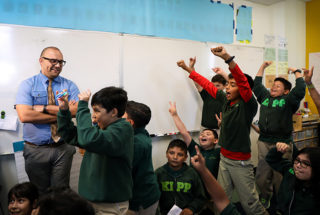Pair of honors for KIPP LA: 2 teachers named national award-winners, and CREDO study cites learning gains
ByEsmeralda Fabián Romero
Read the full article at LASchoolReport.com >
High academic expectations and an “alive” and engaged classroom with lots of student-teacher interaction are some of the hallmarks of Joshua Martinez’s East Los Angeles class, where he has taught fourth-grade for the last five years.
Martínez has been named one of four winners of the 2017 Fishman Prize for his “superlative classroom practice” at KIPP Raíces Academy, a public charter elementary school with a nearly 100 percent Latino and nearly 90 percent disadvantaged student population.
The Fishman Prize recognizes the nation’s most effective teachers working in high-needs public schools with a $25,000 award. It is given yearly by TNPT (The New Teacher Project), a nonprofit striving to end educational inequality by providing excellent teachers to underserved students.
Martínez, 35, says his real reward is being able to work in a school that “supports children.”
“We care about developing a curriculum and a place that’s nurturing for children, not just for academics but also for their social and emotional needs, and where kids feel happy to learn and see learning as an exciting thing,” he said by phone a couple days after he was surprised by students’ families, school officials, and TNTP staff as they presented him with the award in front of his cheering students, who were chanting, “He won, he won!”
A second Los Angeles teacher, also at a KIPP school, was surprised that same day at the end of May in front of her class. Maria Morfin, who teaches fifth-grade at East LA’s charter middle school KIPP Sol Academy, also won the Fishman Prize.
KIPP LA made news again this week when the charter organization was highlighted in a study by Stanford-based CREDO showing that the longer students attend schools in charter networks such as KIPP, the greater their gains. For example in math, students attending schools in charter networks gain, on average, about 34 more days of learning in their first year than similar students in traditional district schools. By their third year in that school, they gain 69 additional days of learning — roughly twice the growth.
KIPP LA serves a total of 6,000 students attending its 13 charter schools located in South and East Los Angeles.
According to KIPP, last school year, more than 70 percent of Morfin’s class scored proficient or advanced in English on the California Assessment of Student Performance and Progress state tests, while only 37 percent of California’s Latino fifth-graders and 65 percent of their white counterparts achieved the same results.
Martínez’s fourth-grade students at KIPP Raíces scored 82 percent advanced and proficient in math and 92 percent in English, compared with 29 percent and 39 percent in LA Unified, respectively. And based on annual Accelerated Reader Data, a computer-adaptive assessment, his students read an average of 1 million words per year — tripling the 300,000 word per year average of a typical fourth-grader.
Last year, KIPP Raíces Academy was the only LA Unified school recognized as a National Blue Ribbon School. This year, another KIPP school in LA, KIPP Los Angeles Prep, received the same distinction.
Morfin, the daughter of Mexican immigrants and a product of public schools in Southeast Los Angeles, where she was born and raised, said she was honored to represent her school and represent East LA nationally with this recognition.
“I want my students to have that high-quality education that allows them to go to college and make their dreams come true,” she said by phone.
Morfin, 27, believes that one of the biggest challenges of teaching in the East LA community is dealing with students’ social and emotional needs. She has no children of her own yet but sees her students as her own kids and dedicates most of her time inside and outside of the classroom to them. “I already have too many children, they’re like my own,” she joked. “I see them as children and not only as my students, that allows me to help them be successful in school.”
Martínez, who has Mexican and Irish heritage, believes that for students, having a teacher who shares the same background and understands their Latino culture contributes to how engaged they are in the classroom.
“I feel really proud to be a face that my kids can see as an example of where hard work and determination will take you,” he said. Martínez understands and speaks some Spanish, but he would like to speak it better, so that’s why he encourages his students to use their bilingual skills. “I tell them to feel proud of being bilingual.”
Martínez and Morfin recognize that their work is much easier because of the support they receive from their students’ parents. Working side by side, they have been able to prove that with the right support at school and at home, students even in low-income areas can perform at grade level and higher.
“Parents want their children to learn,” Morfin said, “so I need to find a way to bridge the home experience and the school experience, taking the time to sit with parents, learning how can we work together as a team so we can help their child grow.”
Martínez and Morfin were selected as winners from nearly 800 applications nationwide this year. Applicants undergo a rigorous six-month selection process in which they must demonstrate quality instruction and a commitment to creating life-changing relationships and learning experiences for all students through submitting essays, classroom videos, samples of student work, and letters of reference. They also had an in-person classroom observation and a final in-person interview with an expert panel of judges in New York City.
A third KIPP teacher was also a Fishman Prize winner this year: Brett Noble is an 11th-grade English teacher at KIPP Pride High School in Gaston, N.C. The fourth winner was Milton Bryant, a fifth-grade teacher at Ketcham Elementary School in Washington, D.C.
